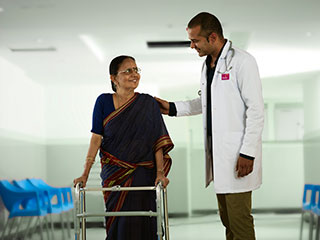World Elders Day is observed today (1st October) and World Osteoporosis Day is observed on 20th October every year.
Hence this month’s Kway focuses on the importance of leading a healthy life, being mobile and independent always …For this we need to keep our bones healthy and should prevent the early wear and tear of it. HEALTHY BONES AND HEALTHY MOBILITY go hand-in-hand when it comes to elderly care. The pandemic has defenetly reduced our physical activities during these times and the diet also been affected by the challenges in shopping for the right quality of food. The following article will be of much use. Healthy and Happy Elders Day!!!
A disease-free life is something everyone wishes for. Thanks to the development in medical sciences, people now live longer compared to the previous generation. However, this is not without any challenges being posed on medical science. With the greying of the population, osteoporosis is more prevalent now than ever before. It is a common bone disease which decreases the bone mass thus affecting the micro architecture and making the body prone to fracture.

Although bone is lost with age in both the genders, there is an accelerated phase of bone loss after menopause in women. Other contributing causes include a diet with poor calcium and vitamin D, hormone disturbances, sedentary lifestyle, cigarette smoking, alcohol and drugs like steroids. The clinical significance of osteoporosis lies in the fact that it increases the risk of fragility fractures by 2 to 3 times. Moreover, such fragility fractures follow a trivial or low velocity injury like a skid and fall while attempting to stand. Such fragility fractures in the elderly will affect their physical and mental well-being. Also, the increasing incidence poses a socioeconomic threat to the public healthcare system. Hence, knowledge about fall prevention can save the patient and prevent over burdening of the health care facilities.
If you are an elderly individual, you can try the following to prevent falls. Install grab bars in your bathroom, correct slippery and uneven flooring, be aware and avoid clutters or wiring on the floor, wear the right shoes which provide a good grip, make sure the rooms are well lit, have a flashlight handy for power failure, use walking aid if you are in need of support, avoid lifting heavy weight and ask for support when needed.
The three commonly fractured bones are the spine, the hip bone and the wrist bone. Of these, hip and spine injuries often affect the mobility while wrist fractures affect the functionality. Hip fracture in particular can make the patient non-ambulatory which in turn can lead to them harbouring many other comorbidities.
The early stage of the disease causes neither any symptom nor does it give a warning sign. In most cases, people with osteoporosis are left undiagnosed until they develop a fracture. Hence awareness is vital. Talking to your doctor, learning the early features and gaining awareness about the disease can save you from becoming the victim. Early DEXA scan can aid the elderly in assessing their bone mass, density and can also estimate their fracture risk. Early treatment with bisphosphonates and calcium supplements can ensure the adequacy of bone mass and prevent fragility fractures.
Regarding calcium, it is called as the bone mineral since more than 99% of the body calcium is found in the bones. Very negligible yet vital amount is present elsewhere in our body. When the body calcium goes down, it tries to compensate it with resorption from the bones making the bones weak, fragile and demineralised. By eating a variety of healthy foods like dairy products, ragi, dates, salmon, etc. we can maintain our serum calcium level. However, many patients with osteoporosis require calcium supplements. Vitamin D plays a pivotal role in the effective absorption of calcium; hence doctors prefer to supplement calcium and vitamin D together. Diet rich in vitamin D along with sun exposure plays a significant role in bone mineralisation. If you develop a fracture due to osteoporosis, early pain free mobility and functionality should be the predominant objective which may require surgery.
To conclude, if you are an elderly person, especially a woman, discuss with your doctor and get screened for the disease. Have a treatment plan, learn about the medication, and follow the fall prevention protocols and lifestyle changes. If you are a young adult, make sure you work-out. Exercising in early adulthood is the single best preventive measure to avoid osteoporosis in the future.
Let’s stay active and live well.

Dr. S. Kathir Azhagan
Orthopedic Consultant
Kauvery Hospital, Chennai

